Book Recommendations.
2023 IWC Book Recommendations
Provided by:
Kevin D. Stringer, PH.D. - Colonel, U.S. Army, Retired
Madison Urban - IWC Analyst
In the spirit of the Chairman of the Joint Chief’s reading list and the Chief of Naval Operations Professional Reading Program, the leadership of the Irregular Warfare Center offers its irregular warfare reading recommendations for 2023. A host of scholars and practitioners have written innumerable books about irregular warfare (IW) and its constituent historical, cultural, economic, tactical, and diplomatic components. Like many areas of human endeavor that are more art than science, the practitioner or researcher faces the challenge of searching through a vast literature reservoir in the quest for irregular warfare knowledge and enlightenment. This IWC Insights paper provides ten selected titles that support the exploration of the IW sphere and establish a cornerstone for dialogue on the nexus of IW and great power competition. While the following recommendations are by no means a comprehensive or conclusive list, they represent a medley of foundational IW texts, both historical and directional. Each title highlights a certain aspect of IW that promotes further research, challenges assumptions, or instigates debate about the dynamic nature of conflict and the best means for the United States to conduct irregular operations. Each selection has a short overview of the content plus a brief explanation why it is on the list. Where possible, substantive reviews for each book are cited in the endnotes.
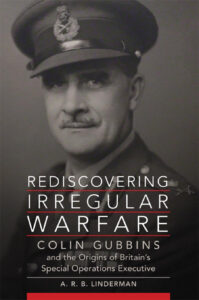
1. Rediscovering Irregular Warfare: Colin Gubbins and the Origins of Britain’s Special Operations Executive
Author: A.R.B. Linderman
Norman: University of Oklahoma Press, 2016
In this slim and well-written volume, A.R.B. Linderman traces the development of British Special Operations Executive (SOE) organization and doctrine by following the biography of Major General Colin Gubbins, the founder of SOE and an understudied figure in the history of modern irregular warfare. The doctrine, training structure, and tactics developed and utilized by SOE were foundational for the development of the American Office of Strategic Services (OSS), the precursor to the modern Central Intelligence Agency and U.S. Army Special Forces. Linderman, through the lens of Gubbins—his writings, public documents, and career experiences—illustrates the establishment and growth of the SOE. Gubbins in fact, presents an excellent example of an officer whose unconventional career path provided him the foundational knowledge needed for leading the SOE effectively. His career history importantly highlights key conflicts that are often overlooked by modern scholars in the study of IW, including the Irish War of Independence and tribal wars in British India during the 1920s, which were both formative to Gubbins’ development as the leader of a pioneering irregular warfare organization.[1]
The following three titles constitute the Stejskal Trilogy, whose author James Stejskal served with the U.S. Army Special Forces and the Central Intelligence Agency. These concise volumes contribute individually to the study and practice of irregular warfare in the areas of advising irregulars and proxies, unconventional warfare, and resistance. The recommended reading sequence would be in historical chronological order.
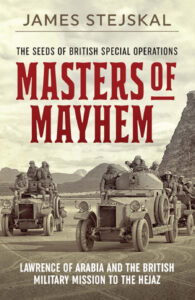
2. Masters of Mayhem: Lawrence of Arabia and the British Military Mission to the Hejaz
Author: James Stejskal
Havertown: Casemate, 2018
While there have been many books written about T.E. Lawrence’s actions in the Middle East during World War I, in Masters of Mayhem, James Stejskal provides a fresh perspective on the Arab Revolt against the Ottoman Empire during the Great War. This concise work details the evolution of an early example of a combined special operations campaign in the modern era. Taking the lessons of the history of T.E. Lawrence and General Edmund Allenby’s Palestinian operations, Stejskal concludes “War is more than the science and art of disposing and maneuvering forces in combat. It consists of continuous innovation, adaptation and modification of techniques, tactics, and procedures. It is a process of merging new with old. What works is kept, what doesn’t is disposed of.” Through the storytelling of this IW effort, this short history highlights the importance of an agile irregular warfare campaign plan that allows for the melding of innovative tactics with new technology, including armored cars and aircraft, while never wavering from the overall goal of the campaign. The book also provides essential insights for modern advisors tasked with working with proxies and irregulars. For a perceptive and concise overview of this pioneering British military mission and its irregular contributions, it’s a must-read for all students of irregular conflict.

3. No Moon as Witness: Missions of the SOE and OSS in World War II
Author: James Stejskal
Havertown: Casemate, 2021
No Moon as Witness is a brief history and overview of the development and deployment of British SOE and American OSS during World War II (WWII). It serves as a primer for those who want to later read the more detailed histories of the SOE and OSS by M.R.D. Foot and others. While both the British and the Americans had fought in guerrilla wars before WWII, the military institutional memory was weak and the capability to conduct irregular war was largely invented as the war went on. Through the detailing of early assessment and training processes, descriptions of the research and development efforts that produced new innovations, and the storytelling of various operations, this work provides a short, easy-to-read introduction to the origins of the United Kingdom and United States’ efforts to develop intelligence and military irregular warfare capabilities in a great power war.[2]
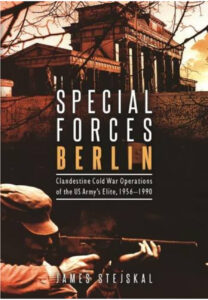
4. Special Forces Berlin: Clandestine Cold War Operations of the US Army’s Elite, 1956-1990
Author: James Stejskal
Havertown: Casemate, 2017
With the current Russo-Ukraine War ongoing and the threat of further Russian aggression possible on the Eastern Front, James Stejskal’s book chronicles the timely history of a little-known special forces unit that applied the concepts of stay-behind forces, clandestine operations, and intelligence tradecraft against the Soviet Union in its heyday. The Special Forces Detachment-Berlin was one of the first units tasked with urban guerrilla warfare, sabotage, and intelligence operations in the event of war in Europe. Interestedly, the formation would later evolve to assume early counterterrorism functions now centralized with Joint Special Operations Command. The book tracks the evolution of the tactics, personnel, foreign partnerships, and mission set across four decades of service. It highlights the importance of developing cultural expertise and language proficiency as well as the benefits of developing training relationships with other countries and units.[3] An added value is that the author is a veteran of the unit, which provides a unique historical perspective.
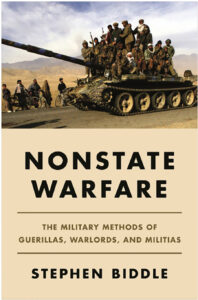
5. Non-State Warfare: The Military Methods of Guerrillas, Warlords, and Militias
Author: Stephen Biddle
Princeton: Princeton University Press, 2021
Current deliberations of national security strategy encourage a shift away from irregular warfare with non-state actors to great power competition with state actors. However, in Non-State Warfare, Stephen Biddle laments that “There is a widespread assumption that state and nonstate warfare are profoundly different phenomena,” when in fact they are not.
Relying on his years as a scholar and strategist, he articulates a continuum of operations that both state and non-state actors employ, often in ways that mimic one another. In challenging irregular warfare assumptions, Biddle helps to articulate a vision for how the American experience and the lessons learned fighting non-state actors in the Middle East can be best understood and properly adapted to great power competition. Amid dramatic pronouncements and calls for drastic changes, Biddle provides a thoughtful, historically grounded approach that emphasizes points of continuity and pushes against siloing the study of conflicts based on the opponent’s status as a state or non-state actor.[4] In fact, he rightly rejects the “widespread assumption that conventional and irregular warfare constitute autonomous, exclusive categories of distinct military conduct,” and challenges the U.S. Department of Defense to think differently and address warfare as a unified whole.
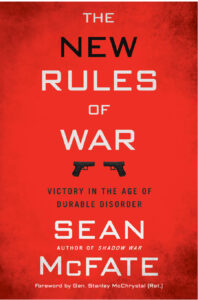
6. The New Rules of War: Victory in the Age of Durable Disorder
Author: Sean McFate
New York, NY: HarperCollins, 2019
Sean McFate is a veteran of the U.S. Army’s 82nd Airborne Division and is a former private military contractor who now serves as a professor of strategy at the National Defense University and Georgetown University’s School of Foreign Service. Written from a practitioner-scholar perspective, his book is framed by the diagnosis that the West loses wars because “we do not know what war is, and if we do not understand it, then we cannot win it.” Seeing this deficit, coupled with idealistic projections about future conflicts that are grounded in the wisdom of conventional war, McFate provides ten rules to describe today’s strategic environment which he argues should provide the basis for realistic planning. McFate’s articulation of the future of warfare confronts assumptions and is primarily descriptive, aimed at outlining the contours of warfare without necessarily prescribing specific solutions. He gives a nod to a challenge his book raises: the temptation for democracies “to sacrifice their values in the name of victory” in light of the complexities of conflict that intentionally subvert the ethics and norms the West promotes. This provocative book is accessible and written to engage a variety of readers–a must-read for both policymakers and practitioners.[5]
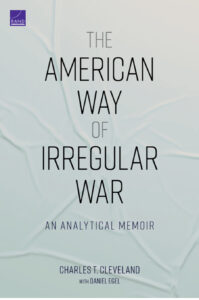
7. The American Way of Irregular War: An Analytical Memoir
Author: Charles Cleveland & Daniel Egel
Santa Monica: Rand, 2020
Lieutenant General (LTG), Retired Charles Cleveland’s analytic memoir is unique among biographies and reports alike. Taking his years of direct experience campaigning in Latin America and commanding the U.S. Army Special Operations Command, LTG (R) Cleveland exposes and diagnoses the United States’ failure to achieve strategic victories in irregular conflicts. He describes his bibliographic memoir as “a story of the waxing and waning of interest and support for IW and the vulnerability that this lack of commitment created. It is a story of strategic successes and failures that have their root, at least in part, in the strengths and weaknesses of that IW capability. It is a story of what the American way of irregular war might look like and how that would enable us to contest the threats that we face today.” Each chapter follows his deployments in Europe, Latin America, and the Middle East, includes six observations from his career, and concludes with recommendations for how the United States should develop IW capability. With decades of experience in IW campaigning, supported by credible research sources, LTG (R) Cleveland provides critical insights into the United States’ failures with a practitioner’s perspective on how to increase its IW capability.[6]
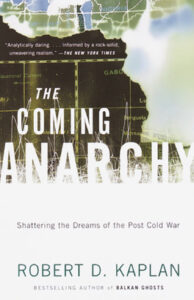
8. The Coming Anarchy
Author: Robert Kaplan
New York: Random House, 2000
Written after the fall of the Soviet Union and amid rosy predictions of peace, democracy, prosperity, and Francis Fukuyama’s “end of history,” Robert Kaplan’s “The Coming Anarchy” cautions against complacency in peacetime or growing overly optimistic about a peaceful future. This work is a collection of long-form articles and essays that predict a complex world full of socio-political challenges driven by crime, disease, tribalism, limited wars, and economic and resource rivalries. After observing the wars in the Balkans, the enduring autocracies in the post-Soviet space, and deep poverty and tribalism in the developing world, Kaplan calls for a realist approach to foreign policy. Like other books on this list, he warns about an overturning of democratic norms, a world where nation-states do not dominate, and conflicts over natural resources. This book remains a valuable reference for IW researchers and practitioners.[7]
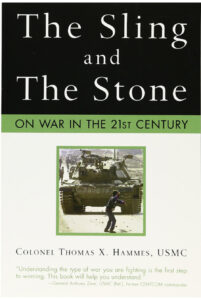
9. The Sling and the Stone
Author: T.X. Hammes
St. Paul: Zenith Press, 2006
In this foundational IW book, T.X. Hammes argues that the U.S. and its allies are unprepared for fourth-generation warfare (4GW). Written in the early years of the wars in Afghanistan and Iraq, Hammes paints a picture of innovative, low-tech, human-centric warfare that is the antithesis to the overwhelming conventional, high-tech military force upon which the U.S. military’s success is based. While a book about the impact of insurgent forces defeating conventional military capabilities may appear irrelevant as the Department of Defense’s reorients to state-on-state conflict, the likelihood of small, messy, and overwhelmingly irregular conflicts is not diminishing. Furthermore, Hammes provides a framework for understanding the social, economic, and political factors that shape the evolution of warfare and illuminates the factors that contributed to prior strategic shifts. Analyzing why conventional force has failed in the past, Hammes offers an enduring perspective with important lessons for navigating future geopolitical conflict.
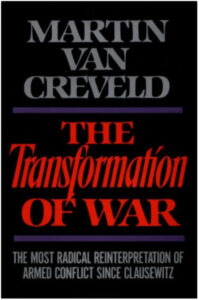
10. The Transformation of War
Author: Martin van Creveld
New York: The Free Press, 1991
Written by one of the foremost Israeli military historians and strategists in 1991, The Transformation of War challenges the traditional Clausewitzian view of war. van Creveld examines the nature of future conflict and the changes in the fundamental questions that undergird war. He argues that traditional answers to these questions are shaped by a world that is fading away or no longer exists, and that when the presumptive answers are wrong, strategies and planning efforts fail. At a macro level, he suggests that the assumption that nation-states fight is an anachronism, and that ethnic and religious tensions will dominate world politics and warfare. He also argues that military tactics will change given this new world. In essence, van Creveld offers “a non-Clausewitzian framework for thinking about war, while…trying to look into its future.” In light of these projections, van Creveld challenges his readers to resist complacency, adjust expectations, and to innovate to prepare for the transformation of war.
Footnotes
[1] Substantive Review: Simon Anglim, review of Rediscovering Irregular Warfare: Colin Gubbins and the Origins of Britain’s Special Operations Executive, by A.R.B. Linderman, British Journal for Military History 2 no. 3 (2016): 122-123, https://bjmh.gold.ac.uk/article/view/670/792.
[2] Substantive Review: John Friberg, review of No Moon as Witness: Missions of the SOE and OSS in World War II, byJames Stejskal, SOF News, July 15, 2021, https://sof.news/books/no-moon-as-witness/.
[3] Substantive Reviews: David Oakley, review of Special Forces Berlin: Clandestine Cold War Operations of the US Army’s Elite, 1956-1990, by James Stejskal, Parameters 51 no. 3, (2021) 147-148, doi:10.55540/0031-1723.3085; James Crabtree, review of Special Forces Berlin: Clandestine Cold War Operations of the US Army’s Elite, 1956-1990, by James Stejskal, Army University Press, August 7, 2020, https://www.armyupress.army.mil/Journals/Military-Review/MR-Book-Reviews/August-2020/Book-Review-002/.
[4] Substantive Reviews: Andrew Maher, review of Nonstate Warfare: The Military Methods of Guerrillas, Warlords, and Militias, by Stephen Biddle, Australian Journal of Defence and Strategic Studies 3, no. 2 (2021): 278-282, https://defence.gov.au/ADC/Publications/AJDSS/documents/volume3-number2/review-nonstate-warfare.pdf; Lionel Beehner, review of Nonstate Warfare: The Military Methods of Guerillas, Warlords, and Militias by Stephen Biddle, Stephen, Political Science Quarterly 137 (2022): 189-192, https://onlinelibrary.wiley.com/doi/epdf/10.1002/polq.13283.
[5] Substantive Reviews: Albert Palazzo, review of The New Rules of War: Victory in the Age of Durable Disorder, by Sean McFate, Australian Army Research Centre, November 18, 2020, https://researchcentre.army.gov.au/library/land-power-forum/book-review-new-rules-war-victory-age-durable-disorder; Reed Bonadonna, review of The New Rules of War: Victory in the Age of Durable Disorder, by Sean McFate, Carnegie Council for Ethics & International Affairs, December 3, 2019, https://www.ethicsandinternationalaffairs.org/2019/the-new-rules-of-war-victory-in-the-age-of-durable-disorder/; Jared Helle, review of The New Rules of War: Victory in the Age of Durable Disorder, by Sean McFate, Journal of Military and Strategic Studies 20 no. 3 (2021): 121-125, https://jmss.org/article/view/72877/54983.
[6] Substantive Reviews: Dave Maxwell, review of The American Way of Irregular War: An Analytical Memoir, by Charles Cleveland & Daniel Egel, Small Wars Journal, July 30, 2020, https://smallwarsjournal.com/blog/american-way-irregular-war-ltg-charles-cleveland-and-daniel-egel; Lt. Col. Gregory Banner, review of The American Way of Irregular War: An Analytical Memoir, by Charles Cleveland & Daniel Egel, Association of the United States Army, April 21, 2021, https://www.ausa.org/articles/may-2021-book-reviews.
[7] Substantive Review: Richard Bernstein, “‘The Coming Anarchy’: Dashing Hopes of Global Harmony,” New York Times, February 23, 2000, https://archive.nytimes.com/www.nytimes.com/library/books/022300kaplan-book-review.html.